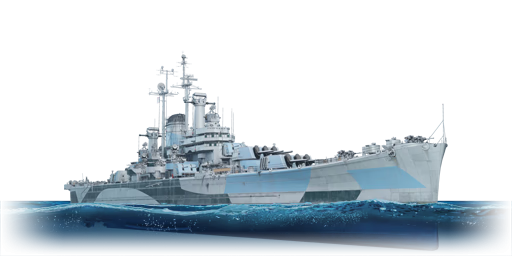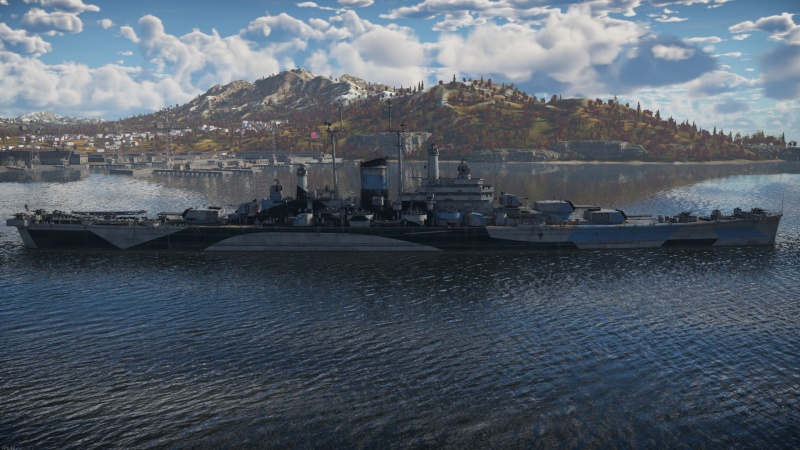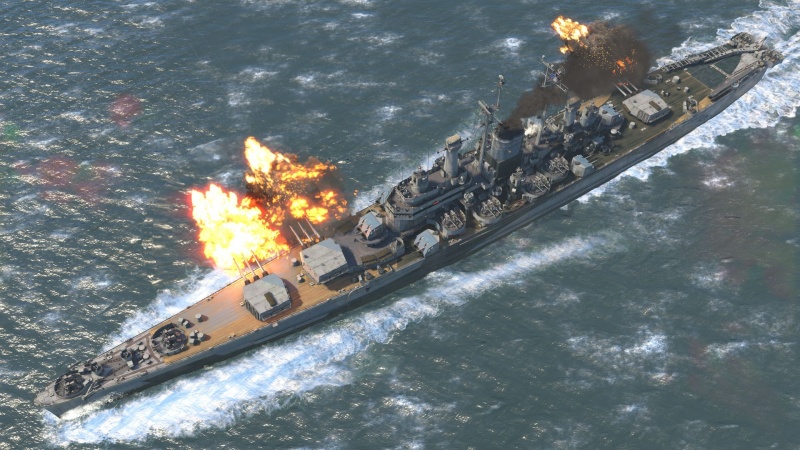Difference between revisions of "USS Des Moines"
guilleibco (talk | contribs) (→Pros and cons) (Tag: Visual edit) |
(→Survivability and armour) |
||
| Line 13: | Line 13: | ||
{{Specs-Fleet-Armour}} | {{Specs-Fleet-Armour}} | ||
<!-- ''Talk about the vehicle's armour. Note the most well-defended and most vulnerable zones, e.g. the ammo magazine. Evaluate the composition of components and assemblies responsible for movement and manoeuvrability. Evaluate the survivability of the primary and secondary armaments separately. Don't forget to mention the size of the crew, which plays an important role in fleet mechanics. Save tips on preserving survivability for the "Usage in battles" section. If necessary, use a graphical template to show the most well-protected or most vulnerable points in the armour.'' --> | <!-- ''Talk about the vehicle's armour. Note the most well-defended and most vulnerable zones, e.g. the ammo magazine. Evaluate the composition of components and assemblies responsible for movement and manoeuvrability. Evaluate the survivability of the primary and secondary armaments separately. Don't forget to mention the size of the crew, which plays an important role in fleet mechanics. Save tips on preserving survivability for the "Usage in battles" section. If necessary, use a graphical template to show the most well-protected or most vulnerable points in the armour.'' --> | ||
| − | + | USS Des Moines, as the lead ship of the [[Des Moines (Family)|Des Moines class]], has an armour layout which is based off the [[Baltimore (Family)|Baltimore class]] heavy cruisers. The main benefit for the main armour belt was to provide protection for the forward magazines, increasing the protection underneath the forward turrets from {{Annotation|0.75 inches|19.05 mm}} to {{Annotation|5.8 inches|147.32 mm}} of armour. The main armour belt is slightly thinner as the [[Baltimore (Family)|Baltimore class]] has a {{Annotation|6-inch|152 mm}} belt, but the extra coverage which the extended belt provides is very welcome. The fore and aft of the citadel are protected by {{Annotation|4.8 inches|121.92 mm}} of bulkhead armour, and thin {{Annotation|0.75-inch|19.05 mm}} bulkheads interspersed throughout the citadel. The decks above the citadel are protected by {{Annotation|1-inch|25.4 mm}} of anti-fragmentation armour just like the destroyers in the US tree. Lower in the ship is a {{Annotation|3.4-inch|86.36 mm}} deck armour plate to deal with incoming fire from long ranges as well; this can deal with other cruisers and lower, however battlecruisers and battleships will easily penetrate this. | |
| + | |||
| + | Des Moines has excellent armour on the turrets, with {{Annotation|8 inches|203.2 mm}} of armour on the turret face, angled at 34 degrees to provide extra protection. This renders the turret face essentially impervious to any cruiser or destroyer fire, so long as it is facing towards the enemy. The turret sides, with only {{Annotation|3.75 inches|95.25 mm}} of armour, can be penetrated by all cruiser calibre and many destroyer calibre guns at close range. The roof is better protected to defeat plunging fire, with {{Annotation|4 inches|101.6 mm}} of armour. The barbettes have less armour, with {{Annotation|6.1 inches|154.94 mm}} of protection. These will be knocked out regularly by other heavy cruisers and every battleship. These lead into the magazines, and the second turret magazine in particular. It is placed in an exposed position above the waterline unlike the Baltimores, so every precaution should be taken to avoid taking fire to this section. When fighting the Des Moines, this is the recommended area to hit. | ||
| + | |||
| + | Similar to other American cruisers, she lacks torpedo bulges, instead relying on fuel tanks along the hull. These cover the entirety of the hull between the turrets, and can absorb some smaller torpedoes, though most will easily punch through. Captains should watch out for torpedo attacks at all times. If taking a hit is inevitable, manoeuvre the ship so that it takes the hit as close to the front of bow as possible, as the bow is mostly empty space and Des Moines can survive a hit here with just some flooding. Any hits below the turrets, especially the second, should be avoided at all costs. | ||
=== Mobility === | === Mobility === | ||
Revision as of 03:16, 16 May 2023
Contents
Description
The Des Moines-class, USS Des Moines (CA-134), 1948 is a premium gift rank V American heavy cruiser with a battle rating of 6.3 (AB/RB/SB). It was introduced in Update "Sky Guardians".
General info
Survivability and armour
USS Des Moines, as the lead ship of the Des Moines class, has an armour layout which is based off the Baltimore class heavy cruisers. The main benefit for the main armour belt was to provide protection for the forward magazines, increasing the protection underneath the forward turrets from 0.75 inches to 5.8 inches of armour. The main armour belt is slightly thinner as the Baltimore class has a 6-inch belt, but the extra coverage which the extended belt provides is very welcome. The fore and aft of the citadel are protected by 4.8 inches of bulkhead armour, and thin 0.75-inch bulkheads interspersed throughout the citadel. The decks above the citadel are protected by 1-inch of anti-fragmentation armour just like the destroyers in the US tree. Lower in the ship is a 3.4-inch deck armour plate to deal with incoming fire from long ranges as well; this can deal with other cruisers and lower, however battlecruisers and battleships will easily penetrate this.
Des Moines has excellent armour on the turrets, with 8 inches of armour on the turret face, angled at 34 degrees to provide extra protection. This renders the turret face essentially impervious to any cruiser or destroyer fire, so long as it is facing towards the enemy. The turret sides, with only 3.75 inches of armour, can be penetrated by all cruiser calibre and many destroyer calibre guns at close range. The roof is better protected to defeat plunging fire, with 4 inches of armour. The barbettes have less armour, with 6.1 inches of protection. These will be knocked out regularly by other heavy cruisers and every battleship. These lead into the magazines, and the second turret magazine in particular. It is placed in an exposed position above the waterline unlike the Baltimores, so every precaution should be taken to avoid taking fire to this section. When fighting the Des Moines, this is the recommended area to hit.
Similar to other American cruisers, she lacks torpedo bulges, instead relying on fuel tanks along the hull. These cover the entirety of the hull between the turrets, and can absorb some smaller torpedoes, though most will easily punch through. Captains should watch out for torpedo attacks at all times. If taking a hit is inevitable, manoeuvre the ship so that it takes the hit as close to the front of bow as possible, as the bow is mostly empty space and Des Moines can survive a hit here with just some flooding. Any hits below the turrets, especially the second, should be avoided at all costs.
Mobility
Write about the ship's mobility. Evaluate its power and manoeuvrability, rudder rerouting speed, stopping speed at full tilt, with its maximum forward and reverse speed.
| Mobility Characteristics | |||
|---|---|---|---|
| Game Mode | Upgrade Status | Maximum Speed (km/h) | |
| Forward | Reverse | ||
| AB | |||
| Upgraded | 71 | 29 | |
| RB/SB | |||
| Upgraded | 61 | 25 | |
Modifications and economy
Armament
Primary armament
Provide information about the characteristics of the primary armament. Evaluate their efficacy in battle based on their reload speed, ballistics and the capacity of their shells. Add a link to the main article about the weapon: {{main|Weapon name (calibre)}}. Broadly describe the ammunition available for the primary armament, and provide recommendations on how to use it and which ammunition to choose.
| Penetration statistics | |||||||
|---|---|---|---|---|---|---|---|
| Ammunition | Type of warhead |
Penetration @ 0° Angle of Attack (mm) | |||||
| 1,000 m | 2,500 m | 5,000 m | 7,500 m | 10,000 m | 15,000 m | ||
| Mk.14 Common | Common | 110 | 98 | 80 | 66 | 56 | 43 |
| Mk.21 APCBC | APCBC | 390 | 348 | 289 | 243 | 207 | 165 |
| Mk.25 HC | HE | 61 | 61 | 61 | 61 | 61 | 61 |
| Mk.17 SP Common | SP Common | 131 | 116 | 95 | 79 | 66 | 50 |
| Shell details | ||||||||||||
|---|---|---|---|---|---|---|---|---|---|---|---|---|
| Ammunition | Type of warhead |
Velocity (m/s) |
Projectile mass (kg) |
Fuse delay (s) |
Fuse sensitivity (mm) |
Explosive mass (TNT equivalent) (kg) |
Ricochet | |||||
| 0% | 50% | 100% | ||||||||||
| Mk.14 Common | Common | 823 | 117.9 | 0.035 | 9 | 4.84 | 47° | 60° | 65° | |||
| Mk.21 APCBC | APCBC | 762 | 151.9 | 0.035 | 9 | 2.21 | 48° | 63° | 71° | |||
| Mk.25 HC | HE | 823 | 117.9 | 0 | 0.1 | 9.49 | 79° | 80° | 81° | |||
| Mk.17 SP Common | SP Common | 823 | 117.9 | 0.035 | 9 | 4.61 | 48° | 63° | 71° | |||
Secondary armament
Some ships are fitted with weapons of various calibres. Secondary armaments are defined as weapons chosen with the control Select secondary weapon. Evaluate the secondary armaments and give advice on how to use them. Describe the ammunition available for the secondary armament. Provide recommendations on how to use them and which ammunition to choose. Remember that any anti-air armament, even heavy calibre weapons, belong in the next section. If there is no secondary armament, remove this section.
| Penetration statistics | |||||||
|---|---|---|---|---|---|---|---|
| Ammunition | Type of warhead |
Penetration @ 0° Angle of Attack (mm) | |||||
| 1,000 m | 2,500 m | 5,000 m | 7,500 m | 10,000 m | 15,000 m | ||
| AAC Mk.34 | HE | 36 | 36 | 36 | 36 | 36 | 36 |
| AAVT Mk.31 | HE-VT | 36 | 36 | 36 | 36 | 36 | 36 |
| SP Common Mk.46 | SP Common | 150 | 125 | 93 | 71 | 56 | 45 |
| Shell details | ||||||||||||
|---|---|---|---|---|---|---|---|---|---|---|---|---|
| Ammunition | Type of warhead |
Velocity (m/s) |
Projectile mass (kg) |
Fuse delay (s) |
Fuse sensitivity (mm) |
Explosive mass (TNT equivalent) (g) |
Ricochet | |||||
| 0% | 50% | 100% | ||||||||||
| AAC Mk.34 | HE | 792 | 25 | 0 | 0.1 | 3,220 | 79° | 80° | 81° | |||
| SP Common Mk.46 | SP Common | 792 | 25 | 0.01 | 6 | 906.5 | 48° | 63° | 71° | |||
| Proximity-fused shell details | ||||||||||||
|---|---|---|---|---|---|---|---|---|---|---|---|---|
| Ammunition | Type of warhead |
Velocity (m/s) |
Projectile mass (kg) |
Fuse delay (s) |
Fuse sensitivity (mm) |
Arming distance (m) |
Trigger radius (m) |
Explosive mass (TNT equivalent) (g) |
Ricochet | |||
| 0% | 50% | 100% | ||||||||||
| AAVT Mk.31 | HE-VT | 792 | 25 | 0 | 0.1 | 457 | 23 | 3,220 | 79° | 80° | 81° | |
Anti-aircraft armament
An important part of the ship's armament responsible for air defence. Anti-aircraft armament is defined by the weapon chosen with the control Select anti-aircraft weapons. Talk about the ship's anti-air cannons and machine guns, the number of guns and their positions, their effective range, and about their overall effectiveness – including against surface targets. If there are no anti-aircraft armaments, remove this section.
Usage in battles
Describe the technique of using this ship, the characteristics of her use in a team and tips on strategy. Abstain from writing an entire guide – don't try to provide a single point of view, but give the reader food for thought. Talk about the most dangerous opponents for this vehicle and provide recommendations on fighting them. If necessary, note the specifics of playing with this vehicle in various modes (AB, RB, SB).
Pros and cons
Pros:
- Adequate speed, on par with the rest of the American ships of this level
- Decent main firepower with an excellent fire rate of 10 rounds per minute
- Has access to a tracking radar
- Powerful auxiliary and AA defense with decent range and effective against both aircraft and light naval targets
- Large crew complement allows for a decent survivability
- Ammo stowage rooms are located below the waterline
- Decent ammo variety for both the 8-inch and 5-inch guns including HE-VT, HE and AP type rounds
- Overall armour is fine
Cons:
- Large and long vessel, quite easy to hit especially with torpedoes
- No torpedo protection
- Doesn't have access to a scout plane
History
Describe the history of the creation and combat usage of the ship in more detail than in the introduction. If the historical reference turns out to be too long, take it to a separate article, taking a link to the article about the ship and adding a block "/History" (example: https://wiki.warthunder.com/(Ship-name)/History) and add a link to it here using the main template. Be sure to reference text and sources by using <ref></ref>, as well as adding them at the end of the article with <references />. This section may also include the ship's dev blog entry (if applicable) and the in-game encyclopedia description (under === In-game description ===, also if applicable).
Media
- Skins
See also
- Related development
External links
| Bethlehem Steel Corporation | |
|---|---|
| Gun Destroyers (DD) | |
| Porter-class | USS Phelps · USS Moffett |
| Fletcher-class | USS Cowell |
| Destroyer Leaders (DL) | |
| Mitscher-class | USS Wilkinson |
| Cruiser, Light (CL) | |
| Omaha-class | USS Raleigh · USS Detroit |
| Heavy Cruisers (CA) | |
| Northampton-class | USS Northampton |
| Portland-class | USS Portland |
| Baltimore-class | USS Baltimore · USS Pittsburgh |
| Des Moines-class | USS Des Moines |
| USA heavy cruisers | |
|---|---|
| Pensacola-class | USS Pensacola |
| Northampton-class | USS Northampton |
| Portland-class | USS Portland |
| New Orleans-class | USS New Orleans |
| Baltimore-class | USS Baltimore · USS Pittsburgh |
| Des Moines-class | USS Des Moines · USS Newport News |
| USA premium ships | |
|---|---|
| Motor torpedo boats | PT-3 · PT-109 · PT-174 · Thunderbolt (PT-556) · PT-658 · PT-811 |
| Motor gun boats | LCM(6) Zippo · USS Douglas · USS Flagstaff |
| Sub-chasers | Carmi (PC-466) |
| Destroyers | USS Welborn C. Wood · USS Wilkinson · USS Bennion · USS Cowell · USS Davis · USS Moffett · USS Phelps · USS Frank Knox |
| Light cruisers | USS Detroit · USS Helena |
| Heavy cruisers | USS Des Moines |
| Battleships | USS Arkansas |






